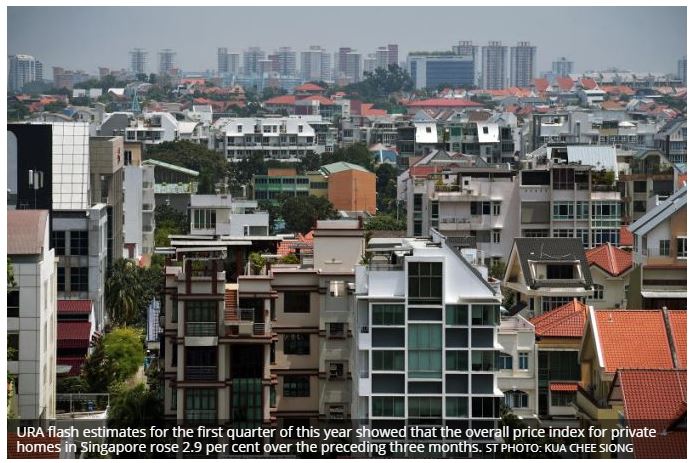Analysts flag higher odds of cooling measures as Singapore private home prices rise for fourth straight quarter
THE odds of a fresh round of cooling measures have been dialled up a notch, with private home prices in Singapore in Q1 rising for a fourth straight quarter.
Singapore private home prices rose 2.9 per cent in Q1 from previous quarter, according to latest flash estimates from the Urban Redevelopment Authority (URA) on Thursday. The price rise comes after a 2.1 per cent increase in Q4 last year.
This is also the sharpest quarterly increase since the second quarter of 2018 when private residential prices rose by 3.4 per cent before property curbs hit in July that year.
The URA flash estimate showed prices of non-landed private homes were up 2.1 per cent in Q1 versus Q4, after a 3 per cent increase in the previous quarter.
Prices of landed properties rose 5.6 per cent quarter on quarter in Q1, after falling 1.6 per cent in Q4.
However, for non-landed homes, prices in the core central region slipped 0.3 per cent in Q1, reversing a 3.2 per cent growth in Q4.
In the rest of central region or city fringe, prices went up by 6.1 per cent, building on the 4.4 per cent rise in the previous quarter.
In the outside central region or suburbs, prices rose by 0.9 per cent in Q1, compared with an increase of 1.8 per cent in Q4.
Lee Sze Teck, director of research at Huttons Asia, said chances of cooling measures have been “raised by a notch” as the government looks to keep prices in check.
“First-time home buyers are likely to be unaffected as past measures have targeted investors and foreign buyers. Wealth taxes in the form of ABSD (Additional Buyer’s Stamp Duty) may take centre stage and Singapore will be one of the first few countries in the region to tax the rich,” he said. “Another possible measure is the tightening of TDSR (Total Debt Servicing Ratio) for investors and foreign buyers while keeping it unchanged for first time home buyers.”
ABSD is additional tax levied on top of Buyer’s Stamp Duty, a tax that property buyers fork out for a property. TDSR caps the amount borrowers can spend on debt repayments to 60 per cent of their gross monthly income.
Mr Lee said the final tally for the private residential market could possibly see a higher price increase when figures for March are in. These would include transactions for the launch at Midtown Modern. Meanwhile, the 20-unit luxury development Eden was fully sold at an average price of S$4,827 per square foot (psf) while in the Good Class Bungalow market, a record sale in the Nassim area was done at S$4,005 psf just days ago.
Citigroup analyst Brandon Lee also sees upside risk to the flash estimate when the statistics are updated later this month.
He noted that if the quarterly pace of property price increase in the region of 3 per cent is sustained for one to two more quarters, which is likely given upcoming launches are mainly high-end, there is heightened risk of cooling measures.
Ismail Gafoor, CEO of PropNex noted the performance of the private residential market exceeded expectations in 2020 and the main drivers that have spurred sales and supported prices last year continued to propel the market in Q1 this year.
He said that the pace of price growth, particularly in the last two quarters will certainly draw the government’s attention and may heighten the risk of new cooling measures being introduced down the road. Mr Gafoor added: “We believe the final pricing data for Q1 and Q2 this year will be closely watched and a stronger pick-up in home values could likely trigger new measures to keep prices in check.”
Christine Sun, senior vice-president of research & analytics at OrangeTee & Tie, said: “The rock-bottom interest rates may mitigate the impact of property price increases and help keep mortgages affordable for borrowers.”
She noted that Singapore’s economy is expected to see a strong rebound this year, which will help to lift buyer sentiment and lend support to Singapore’s property market.
The flash estimate is compiled based on transaction prices given in contracts submitted for stamp duty payment, and data on units sold by developers up to mid-March. The statistics will be updated on April 23, when the URA releases its full set of real estate statistics for the first quarter.
“Past data have shown that the difference between the quarterly price changes indicated by the flash estimate and the actual price changes could be significant when the change is small,” the URA said in a statement, adding that the public is advised to interpret the flash estimate with caution.
Source: https://www.businesstimes.com.sg/real-estate/analysts-flag-higher-odds-of-cooling-measures-as-singapore-private-home-prices-rise-for


 English
English




